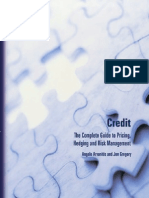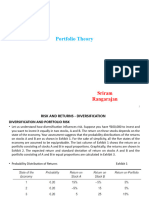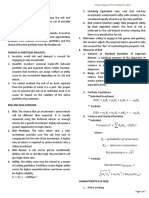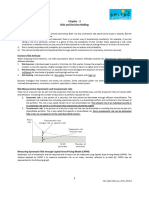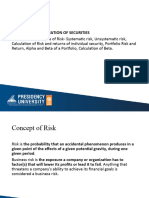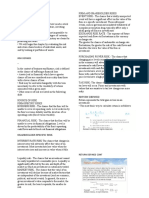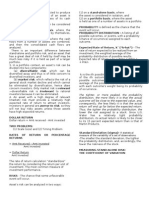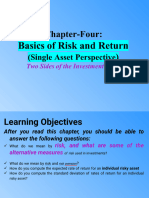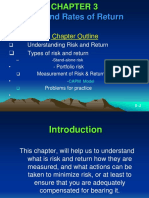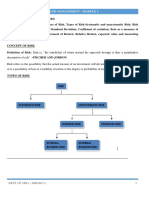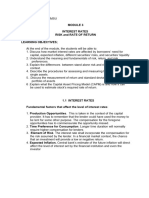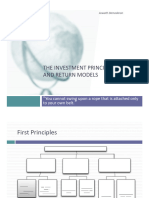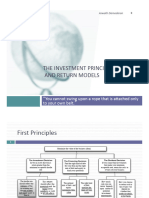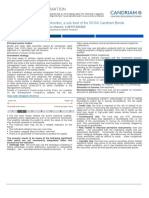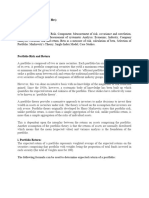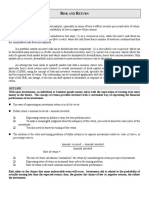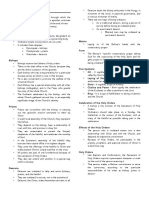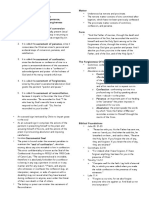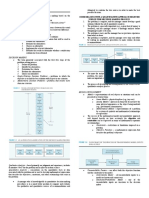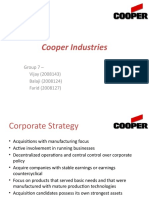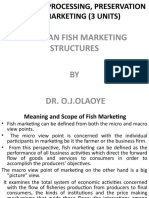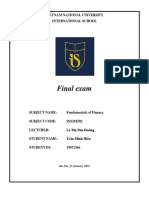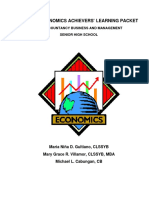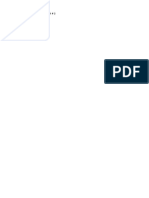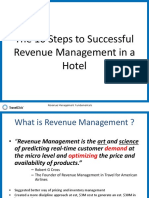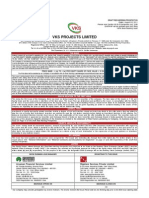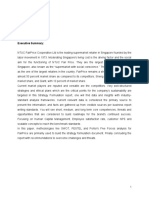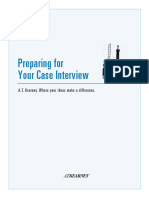Mansci 01: Risks and Returns: The Smaller The Standard Deviation, The Tighter The Probability
Mansci 01: Risks and Returns: The Smaller The Standard Deviation, The Tighter The Probability
Uploaded by
Michelle ManglapusCopyright:
Available Formats
Mansci 01: Risks and Returns: The Smaller The Standard Deviation, The Tighter The Probability
Mansci 01: Risks and Returns: The Smaller The Standard Deviation, The Tighter The Probability
Uploaded by
Michelle ManglapusOriginal Title
Copyright
Available Formats
Share this document
Did you find this document useful?
Is this content inappropriate?
Copyright:
Available Formats
Mansci 01: Risks and Returns: The Smaller The Standard Deviation, The Tighter The Probability
Mansci 01: Risks and Returns: The Smaller The Standard Deviation, The Tighter The Probability
Uploaded by
Michelle ManglapusCopyright:
Available Formats
MANSCI 01: RISKS AND RETURNS RULE #6: The fact that a particular stock goes up and down
E #6: The fact that a particular stock goes up and down is not very
important; what is important is the return on his or her portfolio, and the
portfolio’s risk. Logically, then, the risk and return of an individual security
TYPES OF RISKS
should be analyzed in terms of how that security affects the risk and return of
Credit risk – the risk of default on a debt that may arise from a the portfolio in which it is held.
borrower failing to make required payments
Foreign Exchange Risk – the risk that a foreign currency RULE #7: Diversification can reduce risk, but it cannot eliminate it.
transaction will be negatively exposed to fluctuations in exchange
rates Project X Project Y
Political Risk – the risk faced by investors, corporations, and
Expected Return 60% 8%
governments that political decisions, events, or conditions will
significantly affect the profitability of a business actor or the Standard Deviation 15% 3%
expected value of a given economic action (such as changes in tax Coefficient of Variation 0.25 0.375
laws, environmental regulations, expropriation of assets1) RULE #8: Almost half of the riskiness inherent in an average individual stock
Interest Rate Risk – the risk that the value of a bond or other can be eliminated if the stock is held in a reasonably well-diversified portfolio,
fixed-income investment will suffer as the result of a change in which is one containing 40 or more stocks in a number of different industries.
interest rates
Market Risk – the risk fluctuating returns caused by the Diversifiable Risk – part of a stock’s risk that can be eliminated
macroeconomic factors that affect all risky assets; unavoidable, o Caused by random events (lawsuits, strikes2)
undiversifiable
o Affects only specific companies
o Bad events in one firm will be offset by good events in
RISK ATTITUDES
another
Risk Averse: “Risky securities must have higher expected returns”
Nondiversifiable Risk – market risk
Risk Neutral: “I will use the expected value approach because I
o Stems from factors that systematically affect most firms
am rational towards risk”
(war, inflation, recessions)
Risk-Seeking: “Keep an optimistic attitude toward risk.”
o Since most stocks are affected, this risk cannot be
BASIC PRINCIPLES eliminated by diversification
The risk of an asset can be considered in two ways: Expected Return (Portfolio) – weighted average of the expected
1. On a stand-alone basis, where the asset’s cash flows are analyzed returns of the individual assets that comprise the portfolio
by themselves o Step 1: determine the expected return for the individual
2. In a portfolio context, where the asset’s cash flows are combines assets
with those of other assets o Step 2: multiply the expected return by its investment
proportion
In a portfolio context, an asset’s risk can be divided into two components: o Step 3: Add everything from step 2
1. Diversifiable Risk - can be diversified away and thus is of little o
concern to diversified investors
2. Market Risk – reflects the risk of a general stock market decline,
which cannot be eliminated by diversification, and does concern
investors
Example:
Only market risk is relevant. Diversifiable risk is irrelevant to Assume an investment manager has created a portfolio with the Stock A and
rational investors because it can be eliminated. Stock B. Stock A has an expected return of 20% and a weight of 30% in the
An asset with a high degree of relevant (market) risk must provide portfolio. Stock B has an expected return of 15% and a weight of 70%. What
a relatively high expected rate of return to attract investors. is the expected return of the portfolio?
Investors, in general, are averse to risk, so they will not buy risky
assets unless those assets have high expected returns.
RULE #1: No investment should be undertaken unless the expected rate of
return is high enough to compensate the investor for the perceived risk of the
investment.
Expected Rate of Return – the weighted average of outcomes
RULE #2: The tighter the probability distribution of expected future returns, Covariance – the measure of how two assets related (move)
the smaller the risk of a given investment. together
To measure the tightness of the distribution, use standard deviation
σ (“sigma”)
1
when government takes the assets of an establishment RULE #9: If the covariance of the two assets is positive, the assets move in
2
stoppage of work the same direction. If however, the two assets have a negative covariance, the
assets move in opposite directions. If the covariance of the two assets is zero,
they have no relationship.
RULE #3: The smaller the standard deviation, the tighter the probability
distribution, and accordingly, the less risky the stock. Example:
To choose between two investments if one has a higher expected Assume the mean return (expected return) on Asset A is 10% and the mean
return but the other has a lower standard deviation, use coefficient return on Asset B is 15%. Given the following returns over the past 5 periods,
of variation (CV), which is the standard deviated divided by the calculate the covariance for Asset A as it relates to Asset B.
expected return.
RULE #4: The lower the coefficient of variation, the better.
RULE #5: In a market dominated by risk-averse investors, riskier securities
must have higher expected returns.
Portfolio - combination of different investments
o Risk Premium – the excess return above the investor’s required
rate of return
Example:
Assuming beta of 1.20, a market rate of return of approximately 12%, and an
expected risk-free rate of 4%. What is the required rate of return?
E(R) = 4% + 1.2(12% - 4%) = 13.6%
Security Market Line (SML) – the line that reflects an investment’s risk
versus its return, or the return on a given investment in relation to risk; the
measure of risk used for the security market line is beta
The covariance would equal 18 (90/5).
A shift of the SML can occur with changes in the following:
Correlation Coefficient – the relative measure of the relationship 1. Expected real growth in the economy
between two assets 2. Capital market conditions
o It is between +1 and -1, with a +1 indicating that the two 3. Expected inflation rate
assets move completely together and a -1 indicated that the
two assets move in opposite directions from each other
Example:
Given our covariance of 18 in the previous example, what is the correlation
coefficient for Asset A relative to Asset B if Asset A has a standard deviation
of 4 and Asset B has a standard deviation of 8?
Portfolio Variance
Standard Deviation – the square root of the portfolio variance
Example:
o Stock A, Variance = 350
o Stock B, Variance = 150
o Covariance = 80
CAPITAL ASSET PRICING MODEL (CAPM)
Primary Conclusion: The relevant risk (beta coefficient) of an individual stock
is its contribution to the risk of a well-diversified portfolio
Beta Coefficient – the correlation between the volatility (price variation)
of the stock market and the volatility of the price of the individual stock
Required Rate of Return – the nominal rate of return that an investor
needs in order to make an investment worthwhile; can be estimated by
adding the risk-free rate (determined by government securities) to the
product of the beta coefficient (a measure of the firm’s risk) and the
difference between the market return and the risk-free rate
This return varies over time and is comprised of the following:
o Real Risk-Free Rate – minimum rate of return an investor requires
Nominal Risk-Free Rate – simply the real risk-free rate
of return adjusted for inflation
o
o Inflation Premium
You might also like
- Customer Perception Towards The Mutual FundsDocument56 pagesCustomer Perception Towards The Mutual Fundsshikha gupta50% (2)
- Arvanitis A., Gregory J. Credit.. The Complete Guide To Pricing, Hedging and Risk Management (Risk Books, 2001) (ISBN 1899332731) (439s) FCDocument439 pagesArvanitis A., Gregory J. Credit.. The Complete Guide To Pricing, Hedging and Risk Management (Risk Books, 2001) (ISBN 1899332731) (439s) FCdanghoangminhnhatNo ratings yet
- Chap 3-Corporate FinanceDocument34 pagesChap 3-Corporate FinanceNguyệt Anh NguyễnNo ratings yet
- Financial Management: Topic: Risk & ReturnDocument4 pagesFinancial Management: Topic: Risk & ReturnIris FenelleNo ratings yet
- Risk and Rates of ReturnDocument33 pagesRisk and Rates of ReturnLeyla MalijanNo ratings yet
- Risk & Return 1Document64 pagesRisk & Return 1Prottoy DasNo ratings yet
- Introduction To Portfolio TheoryDocument36 pagesIntroduction To Portfolio TheorySaish ChavanNo ratings yet
- Page 1 of 3Document3 pagesPage 1 of 3Kristine WaliNo ratings yet
- Risk and Rate of ReturnDocument5 pagesRisk and Rate of ReturnKrazy ButterflyNo ratings yet
- Risk Damodaran PDFDocument55 pagesRisk Damodaran PDFMiguel RevillaNo ratings yet
- Risk and Return Concepts PDFDocument3 pagesRisk and Return Concepts PDFyvonneberdosNo ratings yet
- Damodaran On RiskDocument106 pagesDamodaran On Riskgioro_mi100% (1)
- 17 Investment ManagementDocument20 pages17 Investment ManagementAdebajo AbdulrazaqNo ratings yet
- Essentials of Investments 12th Edition Zvi Bodie Alex Kane Alan J Marcus 2Document35 pagesEssentials of Investments 12th Edition Zvi Bodie Alex Kane Alan J Marcus 2reyaelcharifNo ratings yet
- Chapter-3 - Risk and Decision Making - LatestDocument4 pagesChapter-3 - Risk and Decision Making - Latestsabbir AhmedNo ratings yet
- Investmment Chapter TwoDocument10 pagesInvestmment Chapter Twosamuel debebeNo ratings yet
- Risk and Rates of ReturnDocument2 pagesRisk and Rates of ReturnLiana Monica LopezNo ratings yet
- SSRN Id1669398Document64 pagesSSRN Id1669398Michael EnricoNo ratings yet
- Unit 4Document27 pagesUnit 4RAJNo ratings yet
- Lecture Notes On Risks and ReturnsDocument20 pagesLecture Notes On Risks and ReturnsAngelica AllanicNo ratings yet
- Unit-3Document18 pagesUnit-3novice_youthNo ratings yet
- Unit 3Document18 pagesUnit 3anas khanNo ratings yet
- CH 7 M7 Portfolio TheoryDocument28 pagesCH 7 M7 Portfolio Theoryesraam.taghianNo ratings yet
- Week07 Workshop AnswersDocument10 pagesWeek07 Workshop Answersneok30% (1)
- Module 5 RiskDocument8 pagesModule 5 RiskZergaia WPNo ratings yet
- PortfolioDocument18 pagesPortfolioheyNo ratings yet
- Week 01 Risk ManagementDocument20 pagesWeek 01 Risk ManagementChristian Emmanuel DenteNo ratings yet
- Risk and ReturnDocument16 pagesRisk and ReturnMontasir MahmudNo ratings yet
- FinanceDocument1 pageFinancetopnotcher2011No ratings yet
- Answers To Concepts in Review: S R R NDocument5 pagesAnswers To Concepts in Review: S R R NJerine TanNo ratings yet
- Module in Financial Management - 04Document11 pagesModule in Financial Management - 04Angelo DomingoNo ratings yet
- Financial MGT 1 CHAPTER 4 Part IDocument68 pagesFinancial MGT 1 CHAPTER 4 Part IKhalid MuhammadNo ratings yet
- Chapter 4 - RETURN and RiskDocument23 pagesChapter 4 - RETURN and RiskAlester Joseph ĻĕěNo ratings yet
- Unit 5 Portfolio Management I. Portfolio Construction:: ApproachDocument18 pagesUnit 5 Portfolio Management I. Portfolio Construction:: ApproachJ. KNo ratings yet
- Ch-4 Risk and Return-LatestDocument168 pagesCh-4 Risk and Return-Latestshakilhm0% (2)
- Business Finance: You Reap What You SowDocument29 pagesBusiness Finance: You Reap What You SowCandyce ChewNo ratings yet
- Risk & Ret P-I (2022)Document6 pagesRisk & Ret P-I (2022)hardik jainNo ratings yet
- Chapter 5 - Risk and ReturnDocument50 pagesChapter 5 - Risk and ReturnkjNo ratings yet
- IAM - Module - 2 (Theory & Practical Ques)Document12 pagesIAM - Module - 2 (Theory & Practical Ques)Yogitha GowdaNo ratings yet
- FinMar - Module3. Interest Rate and Risk and ReturnDocument12 pagesFinMar - Module3. Interest Rate and Risk and ReturnkeissecretsNo ratings yet
- Discounted Cash Flow Valuation The Inputs: K.ViswanathanDocument47 pagesDiscounted Cash Flow Valuation The Inputs: K.ViswanathanHardik Vibhakar100% (1)
- Risk and ReturnDocument32 pagesRisk and ReturnYeasin ArfatNo ratings yet
- Topic2 Risk and ReturnDocument21 pagesTopic2 Risk and ReturnMirza VejzagicNo ratings yet
- Risk and ReturnDocument32 pagesRisk and Returnmogibol791No ratings yet
- ch6 7Document106 pagesch6 7Fatimah Samsi100% (1)
- Invt FM 1 Chapter-2Document68 pagesInvt FM 1 Chapter-2Khalid MuhammadNo ratings yet
- Risk and ReturnDocument14 pagesRisk and ReturnShafaq Khurram100% (1)
- FM Unit 3 Lecture Notes - Risk and ReturnDocument6 pagesFM Unit 3 Lecture Notes - Risk and ReturnDebbie DebzNo ratings yet
- SAPMDocument37 pagesSAPMrajunbhattNo ratings yet
- L4 Understanding RiskDocument5 pagesL4 Understanding RiskvivianNo ratings yet
- Bond Credit Opp KiidDocument2 pagesBond Credit Opp KiidMassimiliano RizzoNo ratings yet
- CH 9 Risk Management and Investment Management 2F1VD3TVILDocument183 pagesCH 9 Risk Management and Investment Management 2F1VD3TVILMingKeiYimNo ratings yet
- Unit 2 PORTFOLIO RISK AND RETURNDocument19 pagesUnit 2 PORTFOLIO RISK AND RETURNmahi jainNo ratings yet
- Risk and ReturnDocument10 pagesRisk and ReturnMJ BotorNo ratings yet
- And Changes Them According The Risk-Return Profited of The AssetsDocument7 pagesAnd Changes Them According The Risk-Return Profited of The Assetssd5239No ratings yet
- Session 6 SlidesDocument27 pagesSession 6 Slidessimranhayre361No ratings yet
- Implementation of CPPIDocument10 pagesImplementation of CPPIPrateek SamuelNo ratings yet
- Sacrament of MatrimonyDocument4 pagesSacrament of MatrimonyMichelle ManglapusNo ratings yet
- Sacrament of Holy OrdersDocument2 pagesSacrament of Holy OrdersMichelle ManglapusNo ratings yet
- Sacrament of The Anointing of The SickDocument2 pagesSacrament of The Anointing of The SickMichelle ManglapusNo ratings yet
- Sacrament of BaptismDocument2 pagesSacrament of BaptismMichelle Manglapus100% (1)
- Sacrament of ReconciliationDocument2 pagesSacrament of ReconciliationMichelle ManglapusNo ratings yet
- MANSCI Midterm Exam Notes: Chapter 1Document3 pagesMANSCI Midterm Exam Notes: Chapter 1Michelle ManglapusNo ratings yet
- SALES // Chapter 1: Nature & Form of The ContractDocument3 pagesSALES // Chapter 1: Nature & Form of The ContractMichelle ManglapusNo ratings yet
- MANSCI: Introduction To Linear Programming Special CasesDocument1 pageMANSCI: Introduction To Linear Programming Special CasesMichelle ManglapusNo ratings yet
- MANSCI Learning CurvesDocument2 pagesMANSCI Learning CurvesMichelle ManglapusNo ratings yet
- Nature & Form of The Contract: SALES // Chapter 1Document4 pagesNature & Form of The Contract: SALES // Chapter 1Michelle ManglapusNo ratings yet
- Executive SummaryDocument2 pagesExecutive SummarySajid SarwarNo ratings yet
- Brand Plan FormatDocument21 pagesBrand Plan FormatchienNo ratings yet
- About Customer Needs AnalysisDocument7 pagesAbout Customer Needs Analysiskhalida khanNo ratings yet
- IEB - Brochure MIFDocument64 pagesIEB - Brochure MIFShah AtifNo ratings yet
- Daniel HailemichaelDocument70 pagesDaniel HailemichaelBezakulu MinwouyeletNo ratings yet
- Cooper Industries: Group 7 - Vijay (2008143) Balaji (2008124) Farid (2008127)Document9 pagesCooper Industries: Group 7 - Vijay (2008143) Balaji (2008124) Farid (2008127)sfaridahmadNo ratings yet
- Financial InstrumentsDocument3 pagesFinancial InstrumentsGeeta LalwaniNo ratings yet
- TVM, Valuation, Risk and ReturnDocument23 pagesTVM, Valuation, Risk and ReturnSreenivasan PadmanabanNo ratings yet
- Nigerian Fish Marketing Structures BY Dr. O.J.OlaoyeDocument20 pagesNigerian Fish Marketing Structures BY Dr. O.J.Olaoyeabadi girsangNo ratings yet
- Final Exam: Vietnam National University International SchoolDocument8 pagesFinal Exam: Vietnam National University International SchoolKhánh Linh MaiNo ratings yet
- E Ink Case StudyDocument8 pagesE Ink Case StudyJohn Coogan100% (1)
- Huỳnh Tấn Huy Hoàng - BUSI1628 - Assessment 1 (Case Study)Document15 pagesHuỳnh Tấn Huy Hoàng - BUSI1628 - Assessment 1 (Case Study)Dream HoangNo ratings yet
- Applied Economics E-BookDocument184 pagesApplied Economics E-Bookbonbon gabayanNo ratings yet
- Definition of Foreign Exchange MarketDocument2 pagesDefinition of Foreign Exchange MarketSagar MehtaNo ratings yet
- Running Head: Problem Set # 2Document4 pagesRunning Head: Problem Set # 2aksNo ratings yet
- This Study Resource Was: 5.1 Market DemandDocument6 pagesThis Study Resource Was: 5.1 Market DemandFlyfreedomNo ratings yet
- Gernot Wersig - Museums For Far Away PublicsDocument11 pagesGernot Wersig - Museums For Far Away PublicsBernardo ArribadaNo ratings yet
- AFG - Dried Fruits and Nuts PDFDocument88 pagesAFG - Dried Fruits and Nuts PDFPariksha Arya67% (3)
- UNITE-Extended Business Model Canvas-PrintDocument1 pageUNITE-Extended Business Model Canvas-PrintkishoreuxNo ratings yet
- Revenue Management 10 StepsDocument41 pagesRevenue Management 10 StepsTHE1O1BSK AdminNo ratings yet
- Vks Projects LTDDocument263 pagesVks Projects LTDAswathy NairNo ratings yet
- Global Depression Causes (1920s - 1930s) : Name: PD#Document3 pagesGlobal Depression Causes (1920s - 1930s) : Name: PD#strawhatalexNo ratings yet
- ARMSDocument4 pagesARMSWorld NewNo ratings yet
- Ba0508 18-19 2 MSTDocument6 pagesBa0508 18-19 2 MSTccNo ratings yet
- Strategy FormulationDocument27 pagesStrategy Formulationanju antonyNo ratings yet
- Wrigley's Eclipse Case Study - IIMKDocument2 pagesWrigley's Eclipse Case Study - IIMKDeepu SNo ratings yet
- How To 60 MinutesDocument3 pagesHow To 60 MinutesMuh LegyNo ratings yet
- ATKearney CasebookDocument10 pagesATKearney Casebookyul70686No ratings yet

